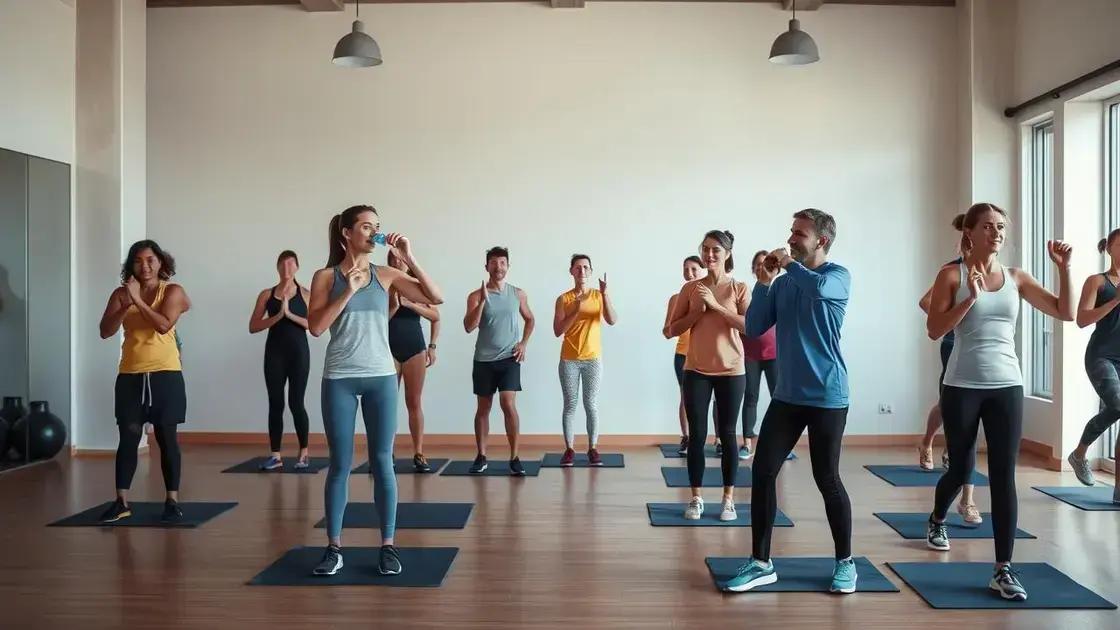Low-impact cardio workouts are safe exercise options designed to elevate heart rate while protecting the joints, offering numerous benefits, including improved cardiovascular health, joint flexibility, and reduced risk of injury. Effective workouts such as walking, swimming, and cycling can be easily incorporated into a fitness routine, making them ideal for individuals seeking to enhance their fitness safely.
Low-impact cardio workouts for joint health are vital for anyone looking to maintain fitness without causing strain on their joints. These workouts offer a safe way to improve cardiovascular health while being gentle on the body. In this article, we’ll delve into the various low-impact cardio options available, their benefits for joint health, and how to incorporate them into your fitness routine safely. Whether you’re a beginner or a seasoned fitness enthusiast, you’ll find valuable insights to help you achieve your health goals.
Understanding Low-Impact Cardio

Understanding Low-Impact Cardio is essential for anyone looking to exercise without stressing their joints. Low-impact cardio refers to activities that elevate your heart rate while minimizing the impact on your body. This type of exercise is especially beneficial for those with joint issues, senior individuals, or beginners who may need a gentler approach to fitness.
Some popular examples of low-impact cardio include walking, swimming, cycling, and aerobic classes that do not involve jumping or high-speed movements. These activities can still provide excellent cardio benefits, such as improved heart health and increased stamina.
How Low-Impact Cardio Works
Low-impact workouts typically involve one foot being in contact with the ground at all times, which reduces the forces that your joints experience. This makes the workouts safer for individuals who may be recovering from injuries or those who have chronic conditions.
By engaging in low-impact cardio, you can enhance your overall fitness levels without the strain. The goal is to find a rhythm that feels comfortable yet effective, allowing you to enjoy the benefits of exercise while protecting your body.
Incorporating Low-Impact Cardio into Your Routine
To incorporate low-impact cardio into your routine, start by identifying the activities you enjoy. Aim for at least 150 minutes of moderate-intensity cardio each week. You can break this down into shorter sessions that fit your schedule. For instance, consider a 30-minute walk five times a week or alternate between different activities to keep things fresh.
Consistency is crucial. By making low-impact cardio a regular part of your life, you will improve your endurance and overall health. It can be helpful to track your progress to stay motivated.
Ultimately, understanding low-impact cardio and its mechanics can empower you to take charge of your health while ensuring the safety of your joints.
Benefits for Joint Health

Engaging in low-impact cardio workouts provides numerous benefits for joint health. First and foremost, these exercises help to maintain a healthy weight. Excess weight can put unnecessary strain on your joints, especially those in your knees and hips. By participating in low-impact workouts, you can burn calories and efficiently manage your weight, which in turn reduces joint stress.
Additionally, low-impact cardio improves joint flexibility and mobility. Routine movement helps to keep the joints flexible, reducing stiffness over time. This is particularly beneficial for older adults or individuals recovering from injury, as they often experience more joint stiffness.
Strengthening Surrounding Muscles
Low-impact cardio also contributes to the strengthening of the muscles surrounding your joints. Strong muscles provide better support and stability, which can help to prevent injuries. For example, cycling can build muscle strength in the legs while being gentle on the knees.
Enhanced Circulation
Another significant benefit is enhanced blood circulation. Low-impact cardio workouts increase blood flow to the muscles and joints, improving nutrient delivery and waste removal. This can lead to faster recovery from workouts and fewer aches or pains.
Moreover, these exercises can also help in reducing inflammation. Regular low-impact workouts can decrease inflammation indicators in the body, which is extremely beneficial for joint health. This decrease can result in less discomfort and better joint function overall.
Finally, low-impact cardio activities often have a lower risk of injury, making them safer for all individuals, particularly those with existing joint issues. Being able to exercise without fear of injury encourages more consistent participation and leads to improved overall health.
Effective Low-Impact Workouts

Choosing effective low-impact workouts can significantly improve your fitness without risking joint strain. Here are some beneficial options to consider:
1. Walking
Walking is one of the simplest and most effective low-impact exercises. Aim for brisk walks in a park or around your neighborhood. To increase intensity, try incorporating inclines or varying your pace.
2. Swimming
Swimming offers a full-body workout while being easy on your joints. The water supports your weight, reducing stress. You can do laps or partake in water aerobics for an exciting alternative.
3. Cycling
Cycling can be done indoors or outdoors. It strengthens the legs and cardiovascular system with minimal impact on the knees and hips. Stationary bikes are great for controlling the intensity.
4. Elliptical Training
Using an elliptical machine provides a solid cardio workout similar to running, but without the pounding impact. You can easily adjust the resistance and incline to suit your fitness level.
5. Yoga and Pilates
Both yoga and Pilates improve flexibility and core strength while promoting relaxation. Many classes focus on low-impact movements, making them great choices for joint health.
By incorporating these effective low-impact workouts into your routine, you can enjoy cardiovascular benefits while reducing the risk of joint discomfort. Be sure to listen to your body and adjust as needed to find what works best for you.
Tips for Safe Exercise

Staying safe during exercise is crucial for promoting joint health. Here are some tips for safe exercise to help you get the most out of your low-impact workouts:
1. Warm-Up and Cool Down
Always start your workouts with a warm-up to prepare your muscles and joints. This can include light walking or gentle stretching. After your workout, take time to cool down and stretch to prevent stiffness.
2. Listen to Your Body
Your body knows best! If you feel pain or discomfort, it’s essential to stop and rest. Pushing through pain can lead to injuries, so pay attention to what your body is telling you.
3. Choose the Right Footwear
Wearing appropriate shoes is important for any exercise regimen. Look for shoes designed for your specific activity, ensuring they provide good support and cushioning to protect your joints.
4. Stay Hydrated
Drinking enough water before, during, and after your workouts helps maintain your hydration levels. Proper hydration supports joint lubrication and overall bodily functions.
5. Mix It Up
Avoid doing the same workout every day. Mixing different low-impact activities can prevent overuse injuries and keeps your routine interesting. Consider rotating between swimming, walking, and cycling.
6. Use Proper Techniques
Using the correct form and techniques during exercises helps avoid unnecessary stress on your joints. If you’re unsure, consider working with a trainer for guidance.
7. Incorporate Rest Days
Rest days are essential for recovery. Your body needs time to heal and adapt after workouts. Aim for at least one or two rest days each week.
By following these tips for safe exercise, you can enjoy low-impact workouts while promoting your joint health effectively.
In Summary: Embrace Low-Impact Cardio for Joint Health
Engaging in low-impact cardio workouts is essential for maintaining joint health while getting fit safely. By understanding the benefits of these exercises, you can improve your cardiovascular health and enhance your overall well-being.
Effective low-impact workouts, such as walking, swimming, and cycling, serve as great options that provide maximum benefits with minimal impact. Incorporating tips for safe exercise ensures you can enjoy these activities without risking injury.
Ultimately, prioritizing low-impact cardio not only protects your joints but also supports a healthier lifestyle. Start your journey toward better joint health today by exploring these workouts and making them a regular part of your fitness routine.
FAQ – Frequently Asked Questions about Low-Impact Cardio Workouts for Joint Health
What are low-impact cardio workouts?
Low-impact cardio workouts are exercises that elevate your heart rate without putting excessive stress on your joints, such as walking, swimming, and cycling.
What are the benefits of low-impact cardio for joint health?
Low-impact cardio helps maintain a healthy weight, improves joint flexibility, strengthens surrounding muscles, enhances circulation, reduces inflammation, and lowers the risk of injury.
How often should I do low-impact cardio workouts?
Aim for at least 150 minutes of moderate-intensity low-impact cardio each week, which you can break down into shorter sessions that fit your schedule.
What tips should I follow for safe low-impact exercise?
Always warm up and cool down, listen to your body, choose the right footwear, stay hydrated, use proper techniques, and incorporate rest days.
Can beginners do low-impact cardio workouts?
Yes, low-impact cardio workouts are ideal for beginners as they provide a safe way to improve fitness without risking injury.
What types of equipment do I need for low-impact workouts?
Equipment can vary, but common items include comfortable shoes, a stationary bike, exercise mats for yoga or Pilates, and access to a pool for swimming.













